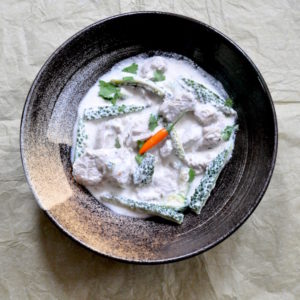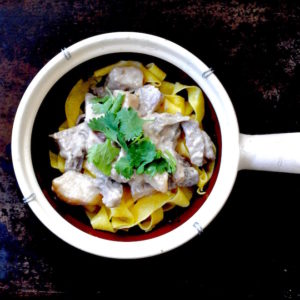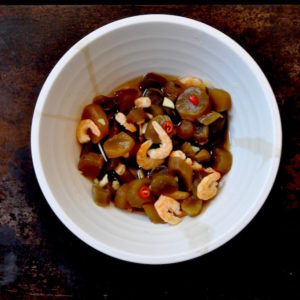Thai Shrimp Paste
Today’s recipe, for Thai Shrimp Paste, flouts a Major Food Blog Rule: Thou Shalt Not Post a Recipe Of Unknown Outcome.

The thing is, shrimp paste is a summer project, requiring protracted periods of heat and warmth. Meaning now–May–is the time to get shrimp pasting. (Never mind that I write on a typically foggy Northern California day.)

Yeah, I could go it alone. But maybe some of you want to play along.

Shrimp paste came about after an extended Thai cooking binge. Said binge led me to David Thompson’s Thai Food , a seminal cookbook in the Thai canon.

I’m often late to the party. But I get there.
Thompson has this to say of Thai shrimp paste, transliterated as gapi or kapi:
Gapi is the soul of Thai food. It is made from planktonic shrimp that have been salted, fermented and then dried in the sun for up to a year. From this unpromising beginning comes an essential component that imparts “Thai-ness” to Thai cooking.
Readily acknowledging the wide availability of commercial shrimp paste, Thompson offers his recipe for “the culinary daredevil.”
That’s me. Culinary daredevil.
Making shrimp paste at home is requires no special equipment. The fish needs to sit in a warm place for two days before being packed into a jar, so you may want to do this over a weekend.

Thai Shrimp Paste (Kapi)
Adapted from David Thompson’s recipe in Thai Food
Yield: about 1/2 pound/4 ounces/113 g Shrimp Paste and some fish sauce
Prep time: The shrimp needs to be salted overnight, then sit in a warm place for two days before being packed into a jar, where it will ferment 2-6 months. As noted in the post, this is a work in progress; readers are invited to follow along.
Please read entire recipe before beginning. All home preservation, curing, and fermentation projects carries some risk. Use common sense. Keep your hands, utensils, and dishes scrupulously clean. When in doubt, throw it out. Never risk your health.
You will need a colander, medium nonporous bowl, large, nonporous plate or platter, mortar and pestle or food processor, and a quart-sized canning jar to prepare shrimp paste. Canning jars are sold individually at hardware stores and some markets. A large-mouthed jar makes getting food in and out much, much easier.
Ingredients
1 pound/464 g highest quality, freshest possible shrimp; see notes for types of shrimp
approximately 1/3 cup/1.5 ounces/45 g Kosher salt
Instructions
Day One:
Place shrimp in colander. Shell if necessary, saving shells for broth, if you are a broth maker. Otherwise, discard. Rinse and pat shrimp very dry with paper towel. Place shrimp in immaculate, medium non-porous bowl. Scatter salt over shrimp in even layer: they don’t need to be frosted, just evenly covered.
You may not use all the salt; I used a scant 1/3 cup/45g.
Leave bowl in warm place overnight. If critters are a concern, cover bowl lightly with plastic wrap or a lid set slightly askew. I set my bowl in a sunny east-facing window, then moved it to the top of the refrigerator.
Day Two:
Discard liquid thrown off by shrimp. Place shrimp in mortar and pound until fluffy. Depending on the size of your mortar, you may need to do this in stages. During this time, the shrimp’s digestive tracts, or “sand veins,” will work free, and you’ll be able to pluck them out (with very clean hands) if you wish.
If using food processor:
process just until shrimp is fluffy–don’t make library paste.
Form shrimp into a rough disk, place on non-porous plate or platter, and cover lightly if necessary (I used plastic wrap). Once again, I returned the plate to the sunny east-facing window, then moved it to the top of the refrigerator.
Day Three:
Sterilize your jar by running it through the dishwasher or washing with hot soapy water and drying it in a 200F/94C oven.
Pound or process your shrimp a final time. You’ll notice the texture has changed dramatically–it will be much drier and fluffier. It should smell surprisingly sweet and taste delicious.
With immaculate hands, roll shrimp paste into a loose ball. Place in bottom of sterilized jar. Cover lightly with a round of plastic wrap. Cap. Label and date. You will forget, believe me.
Place shrimp paste in sunny windowsill. Leave for the summer months.
You will notice the shrimp paste giving off liquid. This, Thompson writes, is fish sauce of such quality that it must be strained, saved, and treasured as a table sauce.
Notes:
Thompson says fresh shrimp of any size will work in this recipe. I used 31-35/pound shrimp in shell.
Thompson says nothing about shrimp shells or removing digestive tracts. Nor does he specify what sort of salt to use.
Now we wait.





